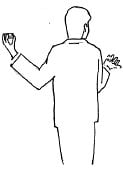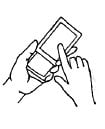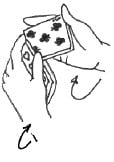
Gary Ouellet put out a fantastic trick, “Finger on the Card” through the Camirand Academy sometime in the early 1980s. I’m unsure of the exact year because my copy carries no copyright (which is strange because of Mr. Ouellet’s lawyerly profession at the time).
Finger on the Card has been one of my favorite routines since 1984 when I first learned it. It is so powerful, that I now reserve it for special circumstances.
My approach to close-up is about entertainment and not power. With my clients, I first assume that they don’t really like magic and therefore my tactic is to win them over, gently. However, after I’ve done my regular close-up set for a group, they often ask for “just one more.” At this point, they are ready to fry. Indeed they have volunteered for me to “hurt them.” This is the time I launch into my version of “Finger on the Card” and I don’t dare try to follow this trick.
Some changes: I fully recommend that you buy and study The Camirand Academy publication. It is inexpensive and of high value. Gary Ouellet’s thinking on the handling is marvelous and full of subtleties that I won’t even mention here. Indeed, through the years I’ve have lost much of the brilliant technique that Gary taught in the instructions. Ouellet would likely laugh at my technique. Yet the intensity of the trick still works for me despite my simplifications.
What makes The Finger on Card better in my opinion than other routine with the same plot, (that is switching in the spectator’s hand) is the apparent openness of handling. Furthermore, the procedure allowed me to seize onto an interesting script idea.
The only thing missing in the Camirand booklet is a script (there is a simple narration of the movements, e.g., “Here is a deck of cards.”) All the action is painstakingly made clear, but to me, that is only the skeleton on which to hang the meat of entertainment. Nevertheless, what a great skeleton!
Context: So here is the scene. We’ve done a series of close-up magic and had some chance to converse with the spectators. They’ve asked for one more trick. You hand out the cards that have been in use and ask for them to be shuffled.
The Script
“Let me ask a personal question; have any of you ever been to a fortuneteller?” Wait for a reply. At least one person in a group of ten adults will have had some encounter with fortune telling. “You have. Was it a man or a woman?” Most say “woman.” If so, “It always is, I don’t know what is wrong with us men” (Adjust this as appropriate to you.) “But women tend to have more intuition.”
The card shuffler should be finished now. Take the cards back.
Turn to the person that said they had been to a fortuneteller and ask, “Did she use cards?” Reply. “I’ve made a study as to how fortunetellers claim to use cards. You shuffled the cards, as a fortuneteller would have had you do.” (Ribbon spread cards face down.) Now as you look at the backs of the cards, they all look the same, but does one catch your eye more than the rest?” (If they say no, comically add, “LET one catch your eye.”)
 “Go ahead and point to that card.” Slide the card out of the pack. Scoop up the deck and hold it aloft, but always in view. Turn your back to the group. (See illustration.) “Show the card to everyone here, but don’t say it out loud. I’ll turn away so that I can’t peek.” Pause. “Let me know when its covered back up.” Turn back to group. Let’s say they chose the jack of hearts. “Go ahead and point to that card.” Slide the card out of the pack. Scoop up the deck and hold it aloft, but always in view. Turn your back to the group. (See illustration.) “Show the card to everyone here, but don’t say it out loud. I’ll turn away so that I can’t peek.” Pause. “Let me know when its covered back up.” Turn back to group. Let’s say they chose the jack of hearts.
Note: It is important to get the entire group in on this. Also it will make sure that the name of card is remembered at the critical ending.
Break the pack near the center. “Place the card back into the pack.” Cover the card and retain a break over the card.
NOTE: Gary Ouellet has some great work here and you owe it to yourself and the trick to research this handling. It is essentially the “Drop Jog” plus an ingenious way to table the deck and still be able to recover the break.
Control the selection to the top and shuffle the deck keeping the selection on top. “We all know that shuffling the cards is a randomizing process. There is no order to cards at all. Yet fortunetellers believe that fate or some unseen force, decides how the cards will fall, thus telling us SOMEthing about the future.” Stop shuffling.
“Now I don’t know if I believe all that, but I think it’s a fun idea to play around with!” Ribbon spread face down. Addressing the selector of the card, “I won’t try to read your future but I will try to use the fortunetellers techniques to find the card your thinking of.
“As you look at the cards again, can you tell which one is yours?” Don’t miss this; it makes everyone understand the impossibility of finding the one in fifty-two. Most often they will say no. “No, of course not, otherwise you’d have my job! Instead, think about your card and then let your finger lay on the back of one card.” They do this. “Okay, slide that card forward but don’t turn it over. And do the same with one more card.” They do.
“Two cards, because I need to know two things about the card in your mind. I’m going to try to read these two cards the way a fortuneteller might.” With the two random cards still on the table scoop up the deck (with the selection still on top) and hold in left dealer position. Add the two tabled cards to the top of the deck, making an issue of which was the first and second one pulled out. This makes no real difference, but I find that it piques spectators’ interest that I seem so concerned about it. I place the first card uppermost, followed by the second; they sit on top of the selection and the balance of the pack.
“I’m going to ask you some questions about your card, I want you to answer only yes or no. Don’t tell me anymore information, particularly don’t tell me the name of your card.” This wording is very important. The only thing that can go wrong in this trick is that someone shouts out the name of the card or say, “that’s my card there!” at the wrong time. So stress the above.
“The first card will tell me about the color of your card. Turn the first card over face up on the deck. (Seven of diamonds) “This is a red card, was your card a red card?” In this case the selected jack of hearts is indeed a red card, so she would say yes. If it is incorrect I say slyly, “So the seven tells me your card was. BLACK!” People laugh, and it starts to show the real truth of fortune telling; that they fish for the correct information! I also add, “Now remember, she picked out the cards so its her fault not mine!” said very tongue-in-cheek, this can be a very genuine and even vulnerable moment for the performer that people will laugh at.
Turn this card face down and push into the deck. “Let’s look at the second card.” Double lift get ready. “Again just tell me yes or no, don’t tell me anymore information. This card should tell me about the suit. It hopefully is also red card” I openly make a face implying, “Hey, I better check!” Pull back the edge of the double and peek. Say, “It is” with a smile. People will laugh again. “This one will tell me if it is a diamond or a heart” Turn the double face up. “This is a heart, was your card a heart?” She’ll say, “Yes.”
 Here, people start to look at each other confused. This is the selection, but you apparently are the only one that doesn’t know that. This is strange for the crowd. You must move fluidly to prevent this moment from getting out of hand. Say, “Good! We’re doing very well.” (Or “doing much better” if the first card missed the color.) Quickly, turn the double face down and keep your right index finger on the center of the card. Move your hands to the tabletop in front of the spectator. Ask them to, “Put your finger on the Jack.” At the same time slide the top card off the deck with right finger, in one smooth movement. (Illustration.) Here, people start to look at each other confused. This is the selection, but you apparently are the only one that doesn’t know that. This is strange for the crowd. You must move fluidly to prevent this moment from getting out of hand. Say, “Good! We’re doing very well.” (Or “doing much better” if the first card missed the color.) Quickly, turn the double face down and keep your right index finger on the center of the card. Move your hands to the tabletop in front of the spectator. Ask them to, “Put your finger on the Jack.” At the same time slide the top card off the deck with right finger, in one smooth movement. (Illustration.)
 “With your other hand, stick your finger in the pack as I riffle by.” Demonstrate the riffle once. Then riffle and allow the spectator to insert her index finger in-between cards. You execute a slip force. As I slip force I rotate my hands so the right hand is palm up and the left palm down (Selection on left packet). Again, see the original instructions for technique. “You stopped the deck, completely at random. Stopping at the (Name the card showing in right hand), but there is another card you stopped at. An unknown card” “With your other hand, stick your finger in the pack as I riffle by.” Demonstrate the riffle once. Then riffle and allow the spectator to insert her index finger in-between cards. You execute a slip force. As I slip force I rotate my hands so the right hand is palm up and the left palm down (Selection on left packet). Again, see the original instructions for technique. “You stopped the deck, completely at random. Stopping at the (Name the card showing in right hand), but there is another card you stopped at. An unknown card”
Table the right-hand half. Take the new top card into your right-hand and add the rest to the packet on the table. Position Check: You should be holding the selection (jack of hearts) and they have their finger on the indifferent card thinking it is the selection. All other cards are on the table.
“Fortunetellers believe that the cards will arrange themselves at the right place at the right time. This should be your card. (Refer to the one you hold.) For the first time say the name of the card you picked.”
You will notice smug glances around the table. People are thinking, “HA! We finally got him!” The spectator will reply, “I picked the Jack of Hearts.”
In recent years I have paused, looked at their finger on the card. I then affect an expression of relief as I act as if I realized they misunderstood me. I add, “No, I mean the first card you picked.” Stare them right in the eye.
I’m sinking the hook in a little deeper. I really want them to have the conviction that I have the wrong card. This heightens the impact substantially.
They will confidently reaffirm the card (jack in this case). Let your gaze trickle back to the card in your right hand. Now affect a determined face.
Take the card into the left hand, and flick its edge with the right. Use both hands to turn it face up. There will be gasps.
This situation sinks in. People act different ways next. But usually there is a scramble for the card under the finger. Often you’ll hear, “But, I have it right he!!!”
Say, “Fortunetellers really do believe the cards move around by themselves.”
|
